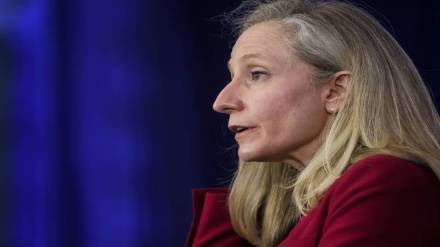Democrat Abigail Spanberger won Virginia’s election for governor on Tuesday, the first of several contests that will serve as an early gauge of how Americans are responding to President Donald Trump‘s tumultuous nine months in office.
Who is Abigail Spanberger?
Spanberger, 46, a former congresswoman and CIA officer, will be the first woman to serve as Virginia’s governor after easily defeating Republican Lieutenant Governor Winsome Earle-Sears.
Meanwhile, in New Jersey’s gubernatorial contest, Decision Desk HQ, a nonpartisan forecaster, projected that Democrat Mikie Sherrill would defeat Republican Jack Ciattarelli. Other news outlets had yet to name a winner.
Across the river in New York City’s mayoral race, Democratic nominee Zohran Mamdani, a 34-year-old democratic socialist, faced 67-year-old Andrew Cuomo, the former governor who ran as an independent after losing to Mamdani in the primary. The campaign laid bare the Democratic Party’s generational and ideological divides as it seeks to rehabilitate its damaged brand.
In California, voters were deciding whether to give Democratic lawmakers the power to redraw the state’s congressional map, expanding a national battle over redistricting that could determine which party controls the U.S. House of Representatives after next year’s midterm elections.
Democrats were watching Tuesday’s results carefully, with the party locked out of power in Washington and struggling to find consensus on the best way to oppose Trump, a Republican, and find a path out of the political wilderness.
Spanberger will succeed outgoing Republican Governor Glenn Youngkin, who could not run for consecutive terms under state law. Her campaign combined an emphasis on lowering the high cost of living with plenty of criticisms of Trump, whose assault on the federal bureaucracy has had an outsized impact in Virginia, adjacent to Washington and home to many government workers.
In interviews at Virginia polling stations on Tuesday, some voters said Trump’s most contentious policies were on their minds, including his efforts to deport immigrants who entered the U.S. illegally and to impose costly tariffs on imports of foreign goods, the legality of which is being weighed by the U.S. Supreme Court this week.
Juan Benitez, a self-described independent, was voting for the first time. The 25-year-old restaurant manager backed all of Virginia’s Democratic candidates because of his opposition to Trump’s immigration policies and the federal government shutdown, for which he blamed Trump.
Voter turnout high
Turnout appeared high across the board.
In New York City, nearly 1.75 million ballots including early voting had been cast as of 6 p.m. ET, according to the board of elections, the most in a mayoral race in more than three decades. Early vote totals in Virginia and New Jersey also outpaced the previous elections in 2021.
The New Jersey race was the most hotly contested campaign, with the contest shattering spending records after both national parties poured millions of dollars into advertising.
A spate of hoax bomb threats sent by email briefly closed down New Jersey polling stations in seven counties in the morning, state officials said.
In New York, Mamdani, who was a little-known lawmaker in New York’s state legislature before his surprising rise, has led by double digits over Cuomo, with Republican nominee Curtis Sliwa, 71, a distant third in most opinion polls.
California’s ballot measure, Proposition 50, which would install a new Democratic-backed congressional map that aims to flip five Republican seats in response to a similar move by Texas, was also widely expected to pass.
While Tuesday’s results will offer some insight into the mood of American voters, the midterm elections are a year away, an eternity in politics.
“There’s nothing that’s going to happen in Virginia or New Jersey that’s going to tell us much about what will happen in a congressional district in Missouri or a Senate race in Maine,” said Douglas Heye, a Republican strategist.
For Democrats, Tuesday’s candidates offer a chance to assess differing playbooks.
Spanberger and Sherrill, both moderate Democrats with backgrounds in national security, put Trump front-and-center, seeking to harness anger at the president’s no-holds-barred agenda.
In New York, Mamdani has proposed more ambitious left-wing policies, including freezing rents for nearly a million apartments and making the city’s buses free.
For Republicans, Tuesday’s elections test whether the voters who powered Trump’s victory in 2024 will still show up when he is not on the ballot.
But Ciattarelli and Earle-Sears, each running in Democratic-leaning states, faced a conundrum: criticizing Trump risked losing his supporters, but embracing him too closely could have alienated moderate and independent voters who disapprove of his policies.
Trump remains unpopular: 57% of Americans disapprove of his job performance, a Reuters/Ipsos poll showed. But Democrats are not gaining support as a result, with respondents evenly split on whether they would favor Democrats or Republicans in 2026.
